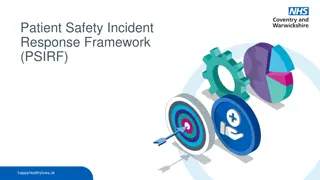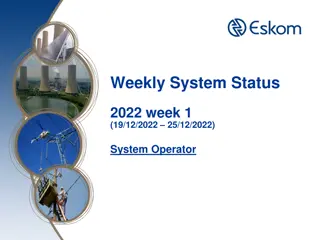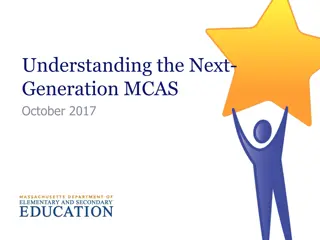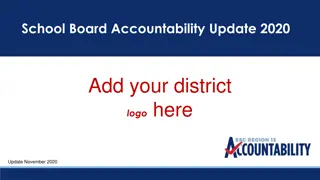Next-Generation Accountability System Framework
Designing a robust accountability system for education involves incorporating both relative (school percentile) and criterion-referenced (targets) components. This system aims to determine accountability through subgroup data analysis, categorize schools based on performance, and include key indicators like achievement measures, student growth, high school completion rates, and additional metrics like chronic absenteeism. The Massachusetts Department of Elementary & Secondary Education emphasizes using accountability percentiles to identify low-performing schools and subgroups for targeted support, evolving towards a comprehensive assessment using the Next-Generation MCAS test.
Download Presentation

Please find below an Image/Link to download the presentation.
The content on the website is provided AS IS for your information and personal use only. It may not be sold, licensed, or shared on other websites without obtaining consent from the author.If you encounter any issues during the download, it is possible that the publisher has removed the file from their server.
You are allowed to download the files provided on this website for personal or commercial use, subject to the condition that they are used lawfully. All files are the property of their respective owners.
The content on the website is provided AS IS for your information and personal use only. It may not be sold, licensed, or shared on other websites without obtaining consent from the author.
E N D
Presentation Transcript
Framework for a Next- Generation Accountability System
01 Accountability design components Relative component accountability percentile 02 Criterion referenced component target setting 03 AGENDA 04 Use of subgroup data for accountability 05 Categorization of schools
Accountability system design components Which indicators will be included? How will the system incorporate both relative (school percentile) & criterion-referenced (targets) components? What subgroups will drive an accountability determination versus just having data reported? How will schools be considered to be meeting targets? How will schools be categorized? 3 Massachusetts Department of Elementary & Secondary Education
Accountability indicators to be included Indicator Achievement Measure(s) ELA, math, & science achievement values (based on scaled score) Student Growth Student growth percentile High School Completion Four-year cohort graduation rate Extended engagement rate Annual dropout rate English Language Proficiency Progress made by students towards attaining English language proficiency Additional Indicators Chronic absenteeism (all schools) Percentage of students passing all grade 9 courses (high schools) Percentage of students completing advanced coursework (high schools) 4 Massachusetts Department of Elementary & Secondary Education
Relative component accountability percentile Accountability percentile calculated using all available indicators for a school Used to identify the lowest performing schools in the state, & same calculation used at the subgroup level to identify low-performing subgroups in need of targeted support 5 Massachusetts Department of Elementary & Secondary Education
Relative component accountability percentile Next-Generation MCAS test allows us to compare all schools, regardless of grade configuration o Separate high school comparison category is transitional & will not be necessary once all schools are administering Next-Generation MCAS tests 6 Massachusetts Department of Elementary & Secondary Education
Criterion-referenced component Focus on closing the achievement gap by raising the achievement floor o Gap-closing can occur as a result of a decline in performance by the high- performing group In addition to meeting targets for the school as a whole, the performance of the lowest performing 25 percent of students in each school will be measured o Every school has a lowest 25 percent of performers o Identified from cohort of students who were enrolled in the school for more than 1 year o Schools will know who these students are 7 Massachusetts Department of Elementary & Secondary Education
Criterion-referenced component Targets set for each accountability indicator, for the school as a whole & for the lowest performing 25 percent of students in each school Points assigned based on progress toward target for each indicator, for both the aggregate & the lowest performing 25 percent of students Exceeded target 4 Declined No change Improved Met target 0 1 2 3 8 Massachusetts Department of Elementary & Secondary Education
Criterion-referenced component Example: Non-high school (weighting to be determined) Points assigned Indicator All students 3 2 2 4 3 2 3 19 Lowest performing students 2 2 1 4 4 4 4 21 ELA scaled score Math scaled score Science achievement ELA SGP Math SGP EL progress Chronic absenteeism Total Combined total points (56 possible) Percentage of possible points 0 = Declined 1 = No change 2 = Improved 3 = Met target 4 = Exceeded target 40 71% 9 Massachusetts Department of Elementary & Secondary Education
Categorization of schools Schools will no longer be placed in a vertical hierarchy of levels 1-5 Number of schools that will be placed into a category based upon a relative standing will be cut in half from previous system o Approximately 90 percent of schools could be categorized based on their own performance against targets Most schools will have 50 percent of its categorization based on students that have been in the school for at least 2 years Category labels are primarily tied to the level of required assistance or intervention Stronger emphasis on schools commended for success 10 Massachusetts Department of Elementary & Secondary Education
Categorization of schools Schools without required assistance or intervention (approx. 85%) Schools requiring assistance or intervention (approx. 15%) Schools of recognition Partially meeting targets Not meeting targets Focused/targeted support Broad/ Meeting targets comprehensive support Schools demonstrating high achievement, significant improvement, or high growth Criterion-referenced target percentage 50-74 Criterion-referenced target percentage 0-49 Non-comprehensive support schools with percentiles 1-10 Schools with low graduation rate Schools with low performing subgroups Schools with low participation Criterion-referenced target percentage 75-100 Underperforming schools Chronically underperforming schools Notes: Category names not finalized School percentiles & performance against targets will be reported for all schools 11 Massachusetts Department of Elementary & Secondary Education
Other considerations & known issues ESE will redesign district & school report cards in 2018 o Will include measures of performance/opportunity beyond assessment & accountability results (e.g., discipline rates, availability of art & other non-core courses, school culture/climate, etc.) 2019 high school assessment transition Middle/high & K-12 schools o Administering both legacy & Next-Generation MCAS tests District accountability o Administering both legacy & Next-Generation MCAS tests o Will not be based on designation of lowest performing school 12 Massachusetts Department of Elementary & Secondary Education
Next steps Upcoming discussions December 19 Board discussion on system framework January 12 Meeting with the Urban Superintendents Network January 17 Meeting with the Superintendents Advisory Council January 23 Board discussion on system refinements & weighting of indicators February 27 Board discussion of proposed amendments to state accountability regulations 13 Massachusetts Department of Elementary & Secondary Education























